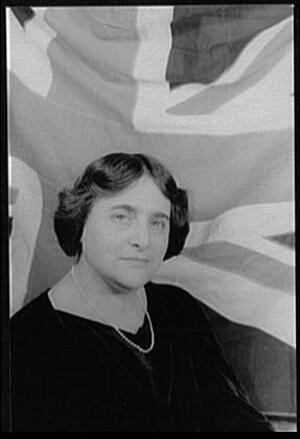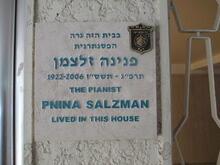Dame Myra Hess
One of Great Britain’s most famous classical pianists, Dame Myra Hess had the idea of setting up lunchtime concerts at London’s National Gallery during the Second World War to boost the low morale of Londoners. The success of the National Gallery concerts made Hess an international star, though she preferred to perform in smaller concert halls. She had a complicated relationship with Judaism; she rejected the Orthodox tradition of her father’s family and was drawn to American Episcopalian teachings, though she never converted for fear of being perceived as a deserter by her fellow Jews. The honor of Dame of the British Empire was conferred upon Hess in 1941.
One of the most potent symbols representing the spirit of war-torn Britain during World War II must be the series of concerts at London’s National Gallery that continued throughout the war. Within a month of hostilities being declared, the National Gallery was closed and its paintings safely stored outside the capital. Cinemas, theaters, and concert halls were all dark; Myra Hess, by then an established concert pianist, was concerned about the effect of this cultural blackout on the lives of Londoners. Towards the end of September 1939, she approached the Director of the Gallery, Kenneth Clark, with the idea of mounting lunchtime classical concerts. Clark shared her concerns and swiftly obtained government approval for the scheme. On Tuesday, October 10, the first lunchtime concert was staged; a resounding success, it was the first of an uninterrupted succession that continued for six and a half years until April 10, 1946, 1,698 concerts later.
Family Life & Myra’s Character
Julia Myra, the youngest of four children, was born in London on February 25, 1890. Her paternal grandfather, Samuel Hess (1824–1905), arrived in England from his native Alsace and set up his own textile firm in London’s East End in 1847. He married English-born Alice Cantor and moved into an elegant Islington home and, an Orthodox Jew, regularly attended Dalston Synagogue. Frederick Solomon, Myra’s father, was the oldest of his seven children, three boys and four girls. Frederick joined his father in the expanding family firm and in 1884 married Lizzie Jacobs (“Lizzie” is the name that appears on the marriage register) at Bayswater Synagogue.
Myra’s character was essentially a paradox. She was serious and disciplined, as was her father, but she also inherited her mother‘s sense of fun, as well as her mother’s small feet and hands; Myra’s hands were so small that her teacher at the Royal Academy of Music created a device to develop her hand span. However, her penchant for Rabelaisian stories, vulgar jokes, and smoking in public was in part, according to her biographer Marion McKenna, a reaction against a restricting upbringing, which included an adherence to Orthodox Jewish practice.
Frederick and Lizzie Hess’s idiosyncratic interpretation of traditional Jewish practice included eating any meat so long as it was not pork or ham, while at the same time prohibiting all forms of vehicular travel on the Sabbath, including riding a bicycle, which the children found irksome. Frederick would go to synagogue with his sons on Friday evening and return to a traditional Sabbath meal; even at the end of her life, Myra could chant the Lit. "sanctification." Prayer recited over a cup of wine at the onset of the Sabbath or Festival.kiddush, the somewhat lengthy benediction over wine that precedes the Sabbath meal. Her attitude to religion was complex. She rejected any level of Orthodox Judaism, recognizing that it was incompatible with the life of a professional musician. She became increasingly drawn to Christianity through the teachings of the American Episcopalian Theodore Parker Ferris, whose circulated sermons she began to read in 1942. However, although she discussed baptism, she did not convert to Christianity, believing the act could be construed as desertion of her fellow Jews.
Music Education
When she was five, Myra Hess began to take lessons in piano and cello but soon abandoned the latter instrument. At seven, she was admitted to Trinity College of Music and was the youngest pupil to receive the Trinity College Certificate. Following her time at Trinity, she went to the Guildhall School of Music where she studied theory and piano under Julia Pascal and Orlando Morgan, composers who subsequently dedicated works to her. However, she objected to any reference to herself as a child prodigy, stating, “I’m glad I didn’t have to begin the life of an artist as a child. … At twenty they are saying, ‘She was not such a good artist as she was at ten.’” She made her début in 1907, aged seventeen, with a recital at the Aeolian Hall.
While at school she met the pianist Irene Scharrer. The two became virtually inseparable and formed a piano duo; however, they were not cousins, as is widely believed. When she was twelve, Hess won the Ada Lewish scholarship to study with the renowned teacher Tobias Matthay at the Royal Academy of Music. Scharrer was also a pupil of his, and he remained an important figure in both their lives. Even after his death Hess commented, “He is always beside me when I play.” Hess, who never married, made abiding friendships with women such as Irene Scharrer and men such as Howard Ferguson, whom she met during her time at the Royal Academy.
International Success & Honors
Always nervous before a performance and subject to periods of depression, Hess claimed, “When I listen to myself play, I feel I am going to my own funeral,” but she was saved by her sense of humor and fund of common sense. She was also happier performing in small halls than large auditoria, but the success of the National Gallery concerts made her an international star, encouraging such idols as Arturo Toscanini to invite her to perform a Beethoven concerto with him and his orchestra during her first postwar tour of America. Her favored programs, however, were uncompromising recitals of works such as the demanding late Beethoven Sonatas.
The honor of Commander of the British Empire was conferred upon her in 1936, followed by Dame of the British Empire in 1941. During the 1960s, increasing bouts of ill health forced her to abandon the concert platform in favor of teaching. She died in London on November 25, 1965. For pianists, a lasting legacy is her transcription of the Bach Chorale Jesu, Joy of Man’s Desiring, and although she was reluctant to enter the recording studio, there remains for all a body of recorded performances that includes invaluable examples of her radio broadcasts.
Ewen, David. “Myra Hess, a Poet in Tones.” The American Hebrew (October 1929): 688.
Grove, George, Stanley Sadie, and John Tyrell (eds.). The New Grove Dictionary of Music and Musicians. New York: Oxford University Press, 2001.
McKenna, Marion. Myra Hess. London: H. Hamilton, 1976.
Scharrer, Irene. “A Unique Friendship.” In Myra Hess: By Her Friends, edited and compiled by Denise Lassimonne and introduced by Howard Ferguson. London: Vanguard Press, 1966.




